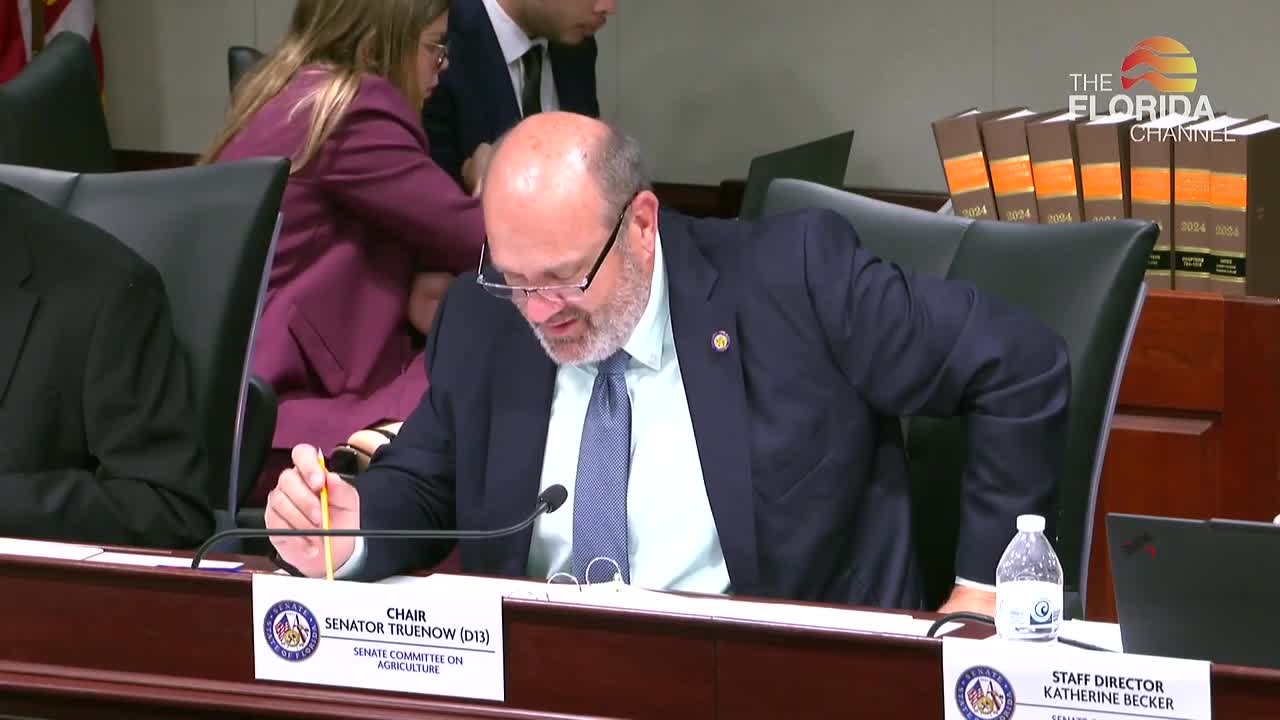UF/IFAS lays out extension strategy to meet Suwannee Valley nitrogen-reduction targets
February 11, 2025 | Agriculture , Standing Committees, Senate, Legislative, Florida
This article was created by AI summarizing key points discussed. AI makes mistakes, so for full details and context, please refer to the video of the full meeting. Please report any errors so we can fix them. Report an error »

The Committee on Agriculture heard a presentation from University of Florida Institute of Food and Agricultural Sciences (UF/IFAS) Regional Extension Agent Bob Hockmuth about steps to reduce nitrogen loads in the Suwannee Valley to meet state Basin Management Action Plan (BMAP) targets.
Hockmuth said the agriculture portion of the Suwannee BMAP recently rose from about 4.2 million pounds of required nitrogen reduction to roughly 5.8 million pounds, and called the target "an urgent situation" for the region. He described an extension strategy that moves research from small plots to farm-scale demonstrations, paired with cost-share incentives, soil moisture sensors, precision nutrient placement and crop-specific measures such as controlled-release fertilizer and petiole sap testing for watermelons.
Hockmuth laid out a stepped approach: replicated research at UF centers; larger plot and farm-scale trials; field days for growers; pilot cost-share projects; and wider adoption through incentive programs. He cited a corn demonstration where precision placement and soil moisture management reportedly reduced nitrogen use on a single farm by 250,000 pounds and saved about 200,000,000 gallons of water after adoption of the practices.
For watermelons and other vegetables, Hockmuth described a blue-dye irrigation demonstration and petiole sap testing used on roughly 100 farms in the Suwannee Valley to calibrate in-season nutrient needs. He said soil moisture sensors are among the most widely adopted best management practices (BMPs) because they help farmers avoid over-irrigation that would carry nitrogen below the root zone.
Hockmuth identified the Suwannee River Partnership, FDACS Office of Ag Water Policy, the Suwannee River Water Management District, Florida Department of Environmental Protection, commodity groups such as the Watermelon Growers Association, and industry partners as key collaborators in funding and scaling these efforts. When asked about farmer willingness and economics, Hockmuth said growers generally want to participate but that adoption at scale requires incentive funding because equipment and technology investments are expensive.
Hockmuth said the team's current plan emphasizes reductions in corn and intensive hay acreage next, with the expectation that modest per-acre reductions across large acreages could meet the new 5.8-million-pound target. He told the committee some current assessments show the region may be ahead of earlier targets but that additional funding and regional-scale projects will be needed to meet the higher goal.
No formal committee vote or regulatory action was taken during the presentation.
Hockmuth said the agriculture portion of the Suwannee BMAP recently rose from about 4.2 million pounds of required nitrogen reduction to roughly 5.8 million pounds, and called the target "an urgent situation" for the region. He described an extension strategy that moves research from small plots to farm-scale demonstrations, paired with cost-share incentives, soil moisture sensors, precision nutrient placement and crop-specific measures such as controlled-release fertilizer and petiole sap testing for watermelons.
Hockmuth laid out a stepped approach: replicated research at UF centers; larger plot and farm-scale trials; field days for growers; pilot cost-share projects; and wider adoption through incentive programs. He cited a corn demonstration where precision placement and soil moisture management reportedly reduced nitrogen use on a single farm by 250,000 pounds and saved about 200,000,000 gallons of water after adoption of the practices.
For watermelons and other vegetables, Hockmuth described a blue-dye irrigation demonstration and petiole sap testing used on roughly 100 farms in the Suwannee Valley to calibrate in-season nutrient needs. He said soil moisture sensors are among the most widely adopted best management practices (BMPs) because they help farmers avoid over-irrigation that would carry nitrogen below the root zone.
Hockmuth identified the Suwannee River Partnership, FDACS Office of Ag Water Policy, the Suwannee River Water Management District, Florida Department of Environmental Protection, commodity groups such as the Watermelon Growers Association, and industry partners as key collaborators in funding and scaling these efforts. When asked about farmer willingness and economics, Hockmuth said growers generally want to participate but that adoption at scale requires incentive funding because equipment and technology investments are expensive.
Hockmuth said the team's current plan emphasizes reductions in corn and intensive hay acreage next, with the expectation that modest per-acre reductions across large acreages could meet the new 5.8-million-pound target. He told the committee some current assessments show the region may be ahead of earlier targets but that additional funding and regional-scale projects will be needed to meet the higher goal.
No formal committee vote or regulatory action was taken during the presentation.
View full meeting
This article is based on a recent meeting—watch the full video and explore the complete transcript for deeper insights into the discussion.
View full meeting